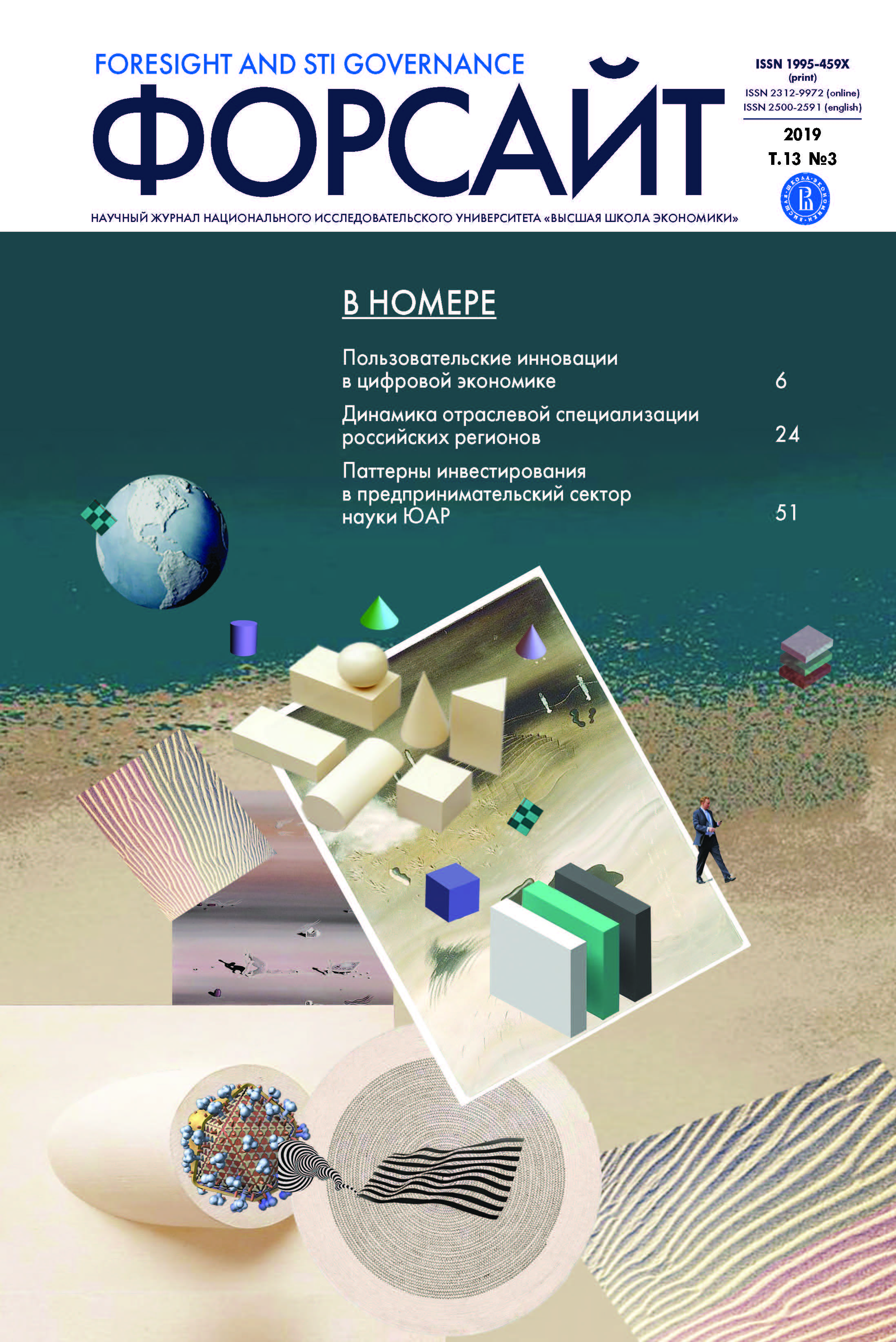Аннотация
В статье обсуждаются технологическая специализация и патентные портфолио российских техноградов — городов, отличающихся наибольшим вкладом в разработку новых технологий в стране. Анализируя патентные данные каждого из них, авторы выделяют технологические области, в которых технограды располагают накопленными конкурентными преимуществами и высоким потенциалом. Изучение их состава позволяет разделить российские технограды на три группы: ориентированные в первую очередь на развитие «высоких» (Москва, Санкт-Петербург, Томск) и «низких» технологий (Краснодар, Пермь), а также имеющие смешанную, high и low-tech специализацию (Воронеж, Уфа, Казань, Новосибирск, Екатеринбург и Самара).
Для целей исследования разработан новый подход к анализу патентной информации, который позволяет получать и агрегировать данные по отдельным административным единицам. Благодаря этому статья может представлять интерес не только для практиков, принимающих решения на региональном или муниципальном уровне, но и для исследователей, работающих в поле региональной экономики, экономической географии, экономики науки, технологий и инноваций.
Литература
Andersson R., Quigley J.M., Wilhelmsson M. (2005) Agglomeration and the special distribution of creativity // Regional Science. Vol. 84. № 3. Р. 445-464.
Archibugi D., Pianta M. (1992) Specialization and size of technological activities in industrial countries: The analysis of patent data // Research Policy. Vol. 21. № 1. P. 79-93.
Balland P.-A., Boschma R., Frenken K. (2015a) Proximity and Innovation: From Statics to Dynamics // Regional Studies. Vol. 49. № 6. P. 907-920.
Balland P.-A., Rigby D., Boschma R. (2015b) The technological resilience of US cities // Cambridge Journal of Regions, Economy and Society. Vol. 9. P. 167-184.
Boschma R. (2015) Towards an Evolutionary Perspective on Regional Resilience // Regional Studies. Vol. 49. № 5. P. 733-751.
Boschma R., Balland P.-A., Kogler D.F. (2014) Relatedness and technological change in cities: The rise and fall of technological knowledge in US metropolitan areas from 1981 to 2010 // Industrial and Corporate Change. Vol. 24. № 1. P. 223-250.
Cantwell J., Vertova G. (2004) Historical evolution of technological diversification // Research Policy. Vol. 33. P. 511-529.
Carlino G., Kerr W. (2014) Agglomeration and Innovation. Working Paper 15-007. Boston, MA: Harvard Business School. Режим доступа: http://real.wharton.upenn.edu/~duranton/Duranton_Papers/Handbook/Agglomeration_and_innovation.pdf, дата обращения 15.11.2018.
Cortright J., Mayer H. (2001) High Tech Specialization: A Comparison of High Technology Centers // Center on Urban and Metropolitan Policy. Washington, D.C.: The Brookings Institution. Режим доступа: https://www.brookings.edu/wp-content/uploads/2016/06/specialization.pdf, дата обращения 15.11.2018.
Dachs B., Mahlich J., Zahradnik G. (2007) The Technological Competencies of Korea's Firms: A Patent Analysis // Innovation and Technology in Korea: Challenges of a Newly Advanced Economy / Eds. J. Mahlich, W. Pascha. Heidelberg, NY: Physica-Verlag. P. 127-146.
Ejermo O. (2005) Technological diversity and Jacob's externality hypothesis revisited // Growth and Change. Vol. 36. № 2. P. 167-195.
Fleming L., Sorenson O. (2001) Technology as a complex adaptive system: Evidence from patent data // Research Policy. Vol. 30. P. 117-132.
Galindo-Rueda F., Verger F. (2016) OECD Taxonomy of Economic Activities Based on R&D Intensity. OECD Science, Technology and Industry Working Paper 2016/04. Paris: OECD.
Giannitsis T., Kager M. (2009) Technology and Specialization: Dilemmas, Options, Risks? Brussels: European Commission.
Glaeser E., Kallal H., Scheinkman J., Shleifer A. (1992) Growth in Cities // The Journal of Political Economy. Vol. 100. № 6. P. 1126-1152.
Grilliches Z. (1990) Patent statistics as economic indicators: A survey // Journal of Economic Literature. Vol. 28. P. 1661-1707.
Ha S.H., Liu W., Cho H., Kim S.H. (2015) Technological advances in the fuel cell vehicle: Patent portfolio management // Technological Forecasting and Social Change. Vol. 100. P. 277-289.
Jacobs J. (1969) The Economy of Cities. New York: Random House.
Jacobs J. (1984) Cities and the Wealth of Nations: Principles of Economic Life. New York: Random House.
Jaffe A., Trajtenberg M., Henderson R. (1993) Geographical localization of knowledge spillovers as evidenced by patent citations // The Quarterly Journal of Economics. Vol. 108. № 3. P. 577-598.
Khramova E., Meissner D., Sagieva G. (2013) Statistical patent analysis indicators as a means of determining country technological specialization. HSE Working Paper. Series: Science, Technology and Innovation, WP BRP 09/STI/2013. Moscow: HSE. Режим доступа: https://www.hse.ru/data/2013/04/10/1297571825/09STI2013.pdf, дата обращения 10.11.2018.
Kogler D.F., Heimeriks G., Leydesdorff L. (2018) Patent portfolio analysis of cities: Statistics and maps of technological inventiveness // European Planning Studies. Vol. 26. № 11. P. 2256-2278.
Kogler D.F., Rigby D., Tucker I. (2013) Mapping Knowledge Space and Technological Relatedness in US Cities // European Planning Studies. Vol. 21. № 9. P. 1374-1391.
O'hUallachain B. (1999) Patent places: Size matters // Journal of Regional Science. Vol. 39. № 4. P. 613-636.
Patel P., Pavitt K. (1997) The technological competencies in the world's largest firms: Сomplex and path dependent, but not too much variety // Research Policy. Vol. 26. P. 141-156.
Pianta M., Meliciani V. (1996) Technological specialization and economic performance in OECD countries // Technology Analysis.
Rigby D. (2015) Technological relatedness and knowledge space: Entry and exit of US cities from patent classes // Regional Studies. Vol. 29. № 11. P. 1922-1937.
Schmoch U. (2008). Concept of a technology classification for country comparisons. Final Report to the World Intellectual Property Organization (WIPO). Karlsruhe: Fraunhofer Institute for Systems and Innovation Research.
Strumsky D., Lobo J., van der Leeuw S. (2012) Using patent technology codes to study technological change // Economics of Innovation and New Technology. Vol. 21. № 3. P. 267-286.
Van Looy B., Vereyen C., Schmoch U. (2014) Patent Statistics: Concordance IPC V8 P. NACE Rev.2. Paris: Eurostat.
Vlckova J., Kasprikova N., Vlckova M. (2018) Technological relatedness, knowledge space and smart specialization: The case of Germany // Moravian Geographical Reports. Vol. 26. № 2. P. 95-108.
Xia L., Hu J.-Y. (2014) Analysis of the relationship between specialization and innovation of technology in Chinese cities // Applied Mechanics and Materials. Vol. 522-524. P. 1577-1580.
Гохберг Л.М. (2003) Статистика науки. М.: ТЕИС.
Роспатент (2018) Отчет о деятельности Роспатента за 2017 г. M.: Роспатент.

Это произведение доступно по лицензии Creative Commons «Attribution» («Атрибуция») 4.0 Всемирная.

